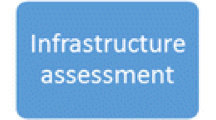Abstract
The telecommunications industry has reached a phase of evolution where mobile communication networks are deployed in the growth market countries. New deployments are performed on an unforeseen scale involving installation of hundreds of base stations a day. The sheer volume of deployments in countries with less mature public infrastructure creates new operational challenges. One large issue at the start of the study was lengthy telecommunication implementation lead time (TILT). The cost of deployment is directly proportional to TILT. In this paper, the constraints of these large deployments were searched, listed and analyzed using the grounded analysis of a case study in India.
Similar content being viewed by others
References
Porter, M. E. (1985). Competitive advantage, creating and sustaining superior performance. New York: The Free Press.
Minzberg, H., Lampel, J., Quinn, J. B., & Ghoshal, S. (2003). The strategy process - concepts, contexts, cases. New Jersey: Prentice Hall.
Porter, M. E. (1996). What is strategy? Harvard Business Review, 74(6), 59–78.
Glaser, B. G., & Strauss, A. L. (1967). The discovery of grounded theory: Strategies for qualitative research. Chicago: Aldine.
Indicus Analytics (2010). How India can ring in a telecom revolution. Refiff.com. http://www.rediff.com/business/slide-show/slide-show-1-tech-india-can-ring-in-a-telecom-revolution/20101029.htm. Accessed 23 January 2011.
Tejas, D. (2010). Indian Telecom Industry - Witnessing A New Begininng. Buzzle.com. http://www.buzzle.com/articles/indian-telecom-industry-witnessing-a-new-begininng.html. Accessed 23 January 2011.
Rajandra, S. (2004). Unified License Regime. Moscow: ITU-D, IMT-2000. http://www.itu.int/ITU-D/imt-2000/Meetings/MoscowApril2004/Abstract%20and%20Bios%20pdf/3-2-4_Abstract.pdf. Accessed 23 January 2011.
Gupta, A. (2009). Mobile Strategies for Rural India. Ovum.com. www.ovum.com.
Department of Telecommunications (2002). Universal Service Obligation Fund. Government of India, Ministry of Communications & Information Technology, Department of Telecommunications. http://www.dot.gov.in/uso/usoindex.htm. Accessed 23 January 2011.
Goyal, N. K. (2007). Telecom in India – Changing Lives. TEMA India. http://www.dof.or.kr/pdf/India%5BWD%5D.pdf. Accessed 23 January 2011.
Parolini, C. (1999). The value net: A tool for competitive strategy. USA: John Wiley.
Warkentin, M., Sugumaran, V., & Bapna, R. (2001). E-knowledge Networks for Inter-organizational Collaborative e-business. Logistics Information Management, 14(1–2), 149–162.
Timmers, P. (2001). Electronic commerce: Strategies and models for business-to-business trading. USA: John Wiley.
Allee, V. (1999). The art and practice of being revolutionary. Journal of Knowledge Management, 3(2), 121–131.
Williamson, O. E. (1985). The economic institutions of capitalism. New York: The Free Press.
Oksanen, P., Hallikas, J., & Sissonen, H. (2010). The evolution of value networks. International Journal of Networking and Virtual Organizations, 7(4), 381–398.
Kaplan, R. S. , & Norton, D. P. (2004). Strategy maps: Converting intangible assets into tangible outcomes. USA: Harvard Business School Press.
Sabat, K. H. (2005). The network investment economics of the mobile wireless industry. Information Systems Frontiers (vol. 7(2), pp.187–206). Springer.
Elvidge, A. M., & Martucci J. (2003). Telecommunications network total cost of ownership and return on investment modeling. BT Technology Journal 21(2), 184–190.
Pöllänen, O., & Säily, M. (2008). Mobile coverage investment model linked to mobile network design. Netnomics Journal, 8, iss. 1–2. Springer.
Sridhar, V. (2010). An econometric analysis of mobile services growth across regions of India. Netnomics Journal, 11(3), 205–220. Springer.
Whitaker, R. M. , Raisanen, L., & Hurley, S. (2005). The infrastructure efficiency of cellular wireless networks. Computer Networks: The International Journal of Computer and Telecommunications Networking, 48(6), 941–959.
Hao, Q., Soong, B., Gunawan, J., Ong, C. B. , & Li, Z. (1997). A low-cost cellular mobile communication system. IEEE Journal of Selected Areas in Communications, 15(7), 1315–1326.
Johansson, K. (2007). Cost effective deployment strategies for heterogeneous wireless networks. Doctoral Dissertation in Telecommunications, Stockholm: Sweden.
Blanco, E. E. (2009). Winning in Emerging Markets: Five Key Supply Chain Capabilities. MIT Center for Transportation and Logistics. http://ctl.mit.edu/sites/default/files/library/public/whitepaper_blanco_emergingmarkets.pdf. Accessed 23 January 2011.
Author information
Authors and Affiliations
Corresponding author
Rights and permissions
About this article
Cite this article
Pöllänen, O., Bhebhe, L. Efficient deployment of large mobile networks. Netnomics 12, 115–132 (2011). https://doi.org/10.1007/s11066-011-9062-9
Accepted:
Published:
Issue Date:
DOI: https://doi.org/10.1007/s11066-011-9062-9




